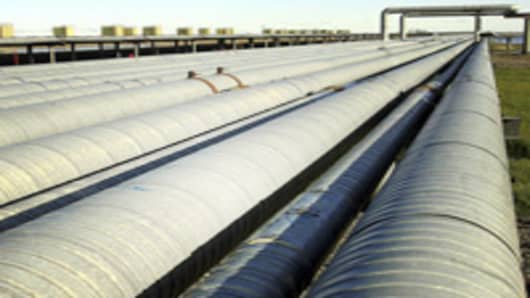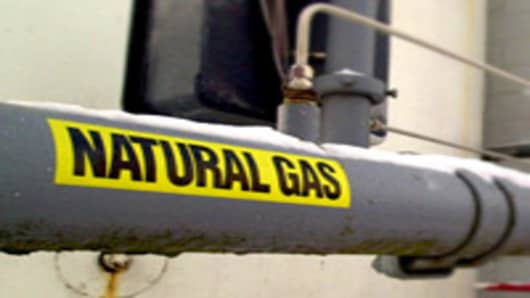Investors looking for commodities exposure with great returns and lower risk may want to check out master limited partnerships (MLPs).
These investments—partnerships that own oil and gas pipelines and storage facilities—throw off great income for investors while providing equities-like liquidity.
Returns have been impressive. From December 2001 to December 2009, the Alerian MLP Index returned 176%, while the S&P 500 offered up 9% and high yield bonds offered 92%.
“Look at it over one, three, five, 15 years,” says John Edwards, MLP analyst at Morgan Keegan, pointing out the returns of MLPs against the S&P 500. “(They are) absolutely crushing the broader market.”
MLPs provide a great dividend-like yield because the partnerships must pass along most of their income to investors through quarterly distributions. Growth in the energy sector also has helped boost returns.
“Some ask ‘How is that (return) even possible?’” Edwards says. “You have very strong distribution components, with an 8-9% yield and 5-10% growth combined with that.”
Created out a tax code change in the mid-80s, MLPs must generate 90% or more of their income from IRS-defined activities, mostly involving the transportation, storage, processing, and distribution of natural resources.
That makes the operation and management of pipelines well-suited for the MLP structure, with around 80 percent of the 70 MLPs available focused on pipelines.
Some private equity management companies — like Blackstone Group and Fortress Investment Group — are also structured as MLPs, but these are the exception.
Under the tax code, 75 to 85 percent of the required quarterly distributions considered a return of capita —therefore not taxable until an investor sells—with the remaining amount taxed as capital gains.
This tax treatment can mean a significant quarterly dividend for investors.
“They tend to trade like bonds (and) offer upside in their ability to increase distributions,” says John White, vice president at Houston-based Triple Double Advisors, a firm that focuses on MLPs.
He adds that while they have a “lot of characteristics” of a bond, investors should note MLPs don’t have a bond’s seniority in the capital structure.
But it’s not just special tax treatment that should attract investors. As exchange-traded entities, MLPs offer great liquidity.
White says “90 to 95 percent” of MLPs trade on exchanges—many on the NYSE—with the liquidity that entails, while firms like UBS , JPMorgan and Credit Suisse also offer ETNs and ETFs that allow investors to take long or short positions on baskets of MLPs.
Many MLPs Are Recession-Resistant
The revenues of many MLPs are recession-resistant as well, making them excellent defensive plays in turbulent economic times.
As pipeline operators, MLPs’ main revenues come from fees paid by energy producers for pipeline capacity that needs to be locked up, whether that producer’s gas is flowing or not.
That helps immunize MLP revenues from drops in energy demand, from problems with extraction or depletion of a gas field and from regulatory risk of shutdowns—as happened in the Gulf of Mexico after the BP disaster.
Most MLPs have an additional volumetric component to their fee structures, ensuring revenues will capture the upside of an increase in energy prices and demand.
This “toll” approach to selling capacity means MLP incomes will rise with bull markets and periods of strong growth—though not as much as exploration, refining and distribution-focused energy companies may in that same environment— while allowing them to weather periods of slowing demand.
Morgan Keegan’s Edwards says MLPs had a “huge bounce” from the bottom of the 2008 market meltdown, and while he called 2009 “a good year.”
But he cautioned returns may not hit those levels for the coming years, especially if economic conditions continue to be sluggish.
“We don’t expect these kids of returns going forward,” he says. “They’ll be much more benign.”
Triple Double’s White says that choosing the right MLP is crucial in this growth climate, adding that his firm sees “midstream” MLPs as more attractive than “upstream” MLPs in the current economic climate.
“Upstream” refers to pipelines from a gas or oil production field to a defined processing or storage point, while “midstream” involves pipelines from that processing or storage point to a refinery, storage facility or terminal.
He says targeting midstream firms, like Enterprise Products Partners , also minimizes extraction and depletion risks, adding that his firm is invested “almost exclusively” in midstream MLPs.
“We look for companies that have well-established assets in Texas and Oklahoma — areas with a lot of production,” he says.
Another plus for investors: more transparency on expenses and overhead compared to other energy-related investments.
With operating costs, pipeline MLPs work like hedge funds—with a general partner (GP) overseeing operational and managerial decisions and limited partner investors providing capital.
Like a hedge fund’s management fee, the GP receives a percentage of the MLP’s distributions as incentive distributions rights as a form of compensation for the management team.
GPs usually receive a minimum of 2% of the limited partners’ distribution. Their percentage of distributions increases, sometimes to up to 50% of distributions, if aggressive performance targets are reached.
But unlike a hedge fund’s management fee, these payments are typically performance-based. If the MLP underperforms, the GP may go unpaid.
All of these characteristics make MLPs worth investigating in times of economic and regulatory upheaval.
While investors may have made better money elsewhere in the ‘90s tech boom – and may have missed a big jump in 2008-2009 — Morgan Keegan’s Edwards says MLPs still make a lot of sense today.
“You’re talking an extremely low-risk proposition,” he says. “(MLPs) tend to do well in bear markets, and let’s face it, we’ve been in a 10-year bear market.”



